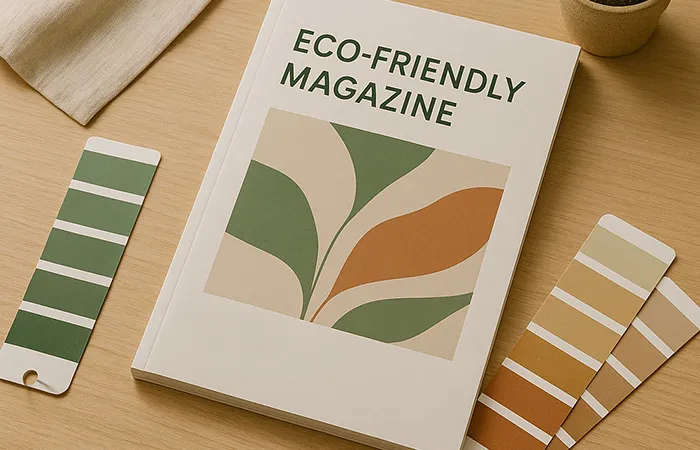
Printing an eco-friendly magazine requires more than using recycled paper. To make a real impact, you need to consider the entire production chain: paper sourcing, inks, energy, transport, and even layout choices. In this guide, we explain how to reduce your magazine’s carbon footprint without sacrificing design or print quality. Whether you're a publisher, association, or creative agency, these principles apply to all formats and budgets.
True sustainability in publishing is not just about materials—it’s about intentional decisions at every step. If you need help selecting eco-certified papers, adjusting your layout to reduce ink usage, or printing close to your distribution area, we can guide you. Sustainable printing is a shared effort between designers, publishers, and printers. It starts with informed choices and realistic strategies.
Understanding Ecolabels: FSC®, PEFC, Blue Angel & More
Ecolabels indicate that the paper or production method complies with recognised environmental standards. FSC® (Forest Stewardship Council) and PEFC (Programme for the Endorsement of Forest Certification) guarantee responsible forest management. The Blue Angel and EU Ecolabel go further, assessing water usage, emissions, and chemical treatments. When choosing certified materials, verify that the labels apply to the exact paper grade and printer you use. Certification ensures transparency, but only when the full chain of custody is respected.
Eco-Friendly Packaging for Magazine Distribution
Packaging has a major impact on the environmental footprint of magazine distribution. To minimise waste, consider replacing plastic polybags with compostable alternatives made from starch or cellulose. Paper wraps and kraft bands are also recyclable and easy to customise with your branding. For bulk deliveries, choose boxes made from 100% recycled cardboard, and avoid overpacking by adjusting box sizes to your print runs. Reducing packaging doesn’t just help the planet—it also lowers transport costs and improves your brand image.
Digital vs. Offset: Which Printing Method Is Greener?
Digital printing generates less waste for small runs and uses fewer setup materials, making it ideal for on-demand eco publishing. However, offset printing becomes more efficient for large runs, especially when using vegetable-based inks and recycled paper. The key lies in run size, ink choice, energy source, and waste management. Ask your printer about their actual environmental practices—sustainability depends less on the machine than on how it's used.
Recycled Paper vs. PEFC or FSC Paper: Which Is Greener?
Recycled paper reduces demand for virgin wood and diverts waste from landfill, making it a strong environmental choice. However, not all recycled stocks are created equal—some require more energy or bleach for processing. FSC® and PEFC-certified virgin papers support responsible forestry but still rely on tree harvesting. The greenest solution depends on your priorities: carbon footprint, biodiversity, or resource circularity. A high-quality recycled paper with low-impact production is often the best balance.
Choosing Eco-Friendly Coatings and Varnishes
Standard lamination and UV varnishes are difficult to recycle and often derived from plastic or petroleum. For a greener finish, choose water-based dispersion varnishes, which are recyclable and less toxic. Biofilms or cellulose-based coatings are biodegradable options for extra durability without harming the environment. Always verify with your printer whether the finish you choose allows the product to remain recyclable or compostable after use.
Involving Your Readers in Your Sustainability Approach
Sustainability is a shared responsibility. Inform your readers about your eco choices—like recycled paper or carbon-offset shipping—and encourage them to recycle or reuse the magazine. Include a small eco message or QR code linking to your environmental policy. You can also invite them to opt for digital editions or subscribe in bulk to reduce waste. When readers understand the impact of their habits, they’re more likely to support brands making real environmental efforts.
Lifecycle of an Eco-Friendly Magazine: From Design to Disposal
Creating a sustainable magazine requires thinking holistically. From low-ink designs and recycled paper selection to local printing and eco-packaging, each stage impacts the final footprint. Plan your design with de-inking in mind (avoiding heavy lamination or metallic inks) and print only what you need. Choose distribution methods with minimal transport emissions, and clearly mark how the magazine should be disposed of. A well-planned lifecycle boosts your environmental credibility—and reduces long-term costs.
Want to take it further?
Go beyond the basics by requesting an LCA (Life Cycle Assessment) or carbon footprint estimate for your next magazine. Some printers can provide carbon offset certificates or work with climate contribution programmes. These options are especially useful for NGOs, publishers, and cultural projects looking to report on their environmental impact.
Choosing a green production route does not mean compromising your vision—it means aligning it with the values of today’s readers and tomorrow’s planet.
Need Help?
We’re happy to help you create a sustainable print strategy. You can request a quote including recycled paper options and eco-friendly finishes, or ask for layout suggestions that minimise ink and waste. Let’s design a magazine that’s both beautiful and responsible.